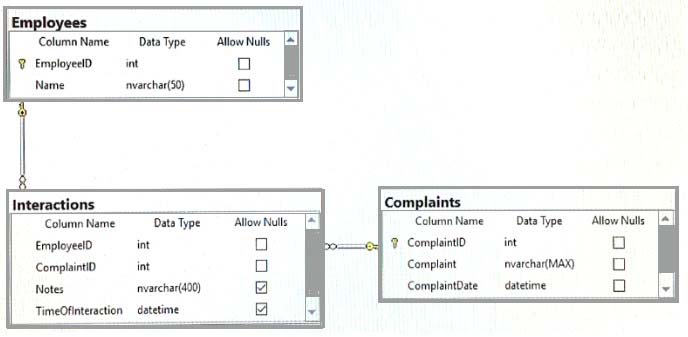

SIMULATION -
You have a database that contains the following tables.
You need to create a query that returns each complaint, the names of the employees handling the complaint, and the notes on each interaction. The Complaint field must be displayed first, followed by the employee's name and the notes. Complaints must be returned even if no interaction has occurred.
Construct the query using the following guidelines:
✑ Use two-part column names.
✑ Use one-part table names.
✑ Use the first letter of the table name as its alias.
✑ Do not Transact-SQL functions.
✑ Do not use implicit joins.
✑ Do not surround object names with square brackets.
Part of the correct Transact-SQL has been provided in the answer area below. Enter the code in the answer area that resolves the problem and meets the stated goals or requirements. You can add code within the code that has been provided as well as below it.
1 SELECT c.Complaint, e.Name, i.Notes
2 FROM Complaints c
3 JOIN __________________
4 JOIN __________________
supermario
Highly Voted 5 years, 1 month agoDieter
Highly Voted 5 years, 8 months agoavramov
5 years, 5 months agotz_123
4 years, 10 months agoAndy7622
4 years, 4 months agoAndy7622
4 years, 4 months agomch185
4 years, 3 months agoBillybob0604
Most Recent 4 years, 3 months agomch185
4 years, 3 months agoVermonster
4 years, 3 months agoOooo
4 years, 7 months agoKiruu23
4 years, 7 months agosadkiss
4 years, 11 months agosadkiss
4 years, 11 months agoOlayemi87
4 years, 12 months agotz_123
4 years, 10 months agoBabyBee
4 years, 5 months agomoehijawe
5 years, 3 months agotz_123
4 years, 10 months ago